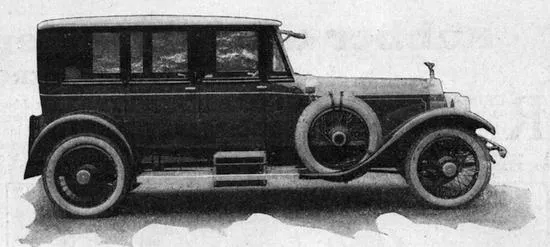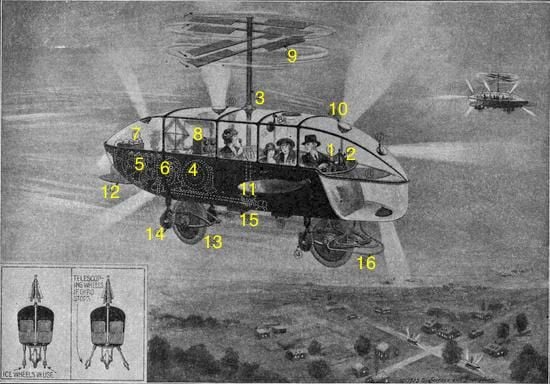1923 Envisions the Two-Wheeled Flying Car of 1973
As cars got larger in the 1920s, the “Helicar” was presented as the solution to congested city streets
/https://tf-cmsv2-smithsonianmag-media.s3.amazonaws.com/filer/201206061150351923-car-of-1973-470x251.jpg)
From the vantage point of 2012 we often associate flying cars with the slick, Jetsonian ideas of the 1950s and ’60s. But predictions of futuristic flying cars buzzing over major American cities are actually about as old as the automobile itself.
The May 1923 issue of Science and Invention featured a two-wheeled flying car that was supposed to be the answer to New York City’s congested streets. Called the “Helicar,” it was stabilized by gyroscopes and operated by a push-button control panel rather than an old-fashioned steering wheel. The Helicar is built of the “lightest materials” available and enclosed in an “unbreakable, unburnable, glasslike substance.” (Its streamlined design actually reminds me a bit of this futuristic auto from 1918.)
The Helicar was dreamt up by none other than the father of modern science fiction, Hugo Gernsback. In February 1904, at the tender age of 19, Gernsback moved to New York from Luxembourg and became intimately familiar with New York City’s busy streets. As cars got larger in the 1920s, Gernsback argued that there was no choice but to give tomorrow’s automobiles the option to soar above the city.
The automobile, as it is built now, tends to become larger and larger. The car of today is fully three times as large as the car of 25 years ago. In our large cities overcrowding, due to the tremendous number of automobiles, has now reached the saturation point. New York City is about to enact a law to eliminate a certain number of taxicabs, which now crowd the streets to such an extent that it is impossible to make any time at all in certain sections of the city. If you really wish to move rapidly, you have to take the subway or the elevated railway. This condition exists in most large cities. It has been proposed to build viaducts over the house tops, but due to the high cost it is doubtful if such a plan will ever become a fact, even in a time remote from now.
The article included a photograph of a Rolls-Royce from 1923, giving retro-futurists of the 2010s a handy perspective on what the top-of-the-line car looked like 90 years ago.

Gernsback believed that the only “practical solution” to New York’s traffic problem was the Helicar, which he predicted to to be in use by 1973. What’s somewhat astounding is that by 1923 the helicopter hadn’t even proven itself as a practical reality yet!
The only practical solution is to combine the automobile with an airplane and this no doubt will happen during the next few decades. The Helicopter Automobile or, for short, the helicar, will not take up very much more room than the present large 7-passenger automobile, nor will it weigh much more than our present-day car, but instead of rolling down the avenue, you will go straight up in the air, and follow the air traffic lines, then descend at any place you wish. This descent can be made in the middle of the street, if necessary. The car may roll through the street, and may rise in an open place, or square, of which there will be many in the future.
While it will be possible for a car to alight on the ground in a narrow street, traffic regulations may prohibit this, and the aerial ascent and descent will be made from these public squares or parks. The Helicar will be particularly useful for suburbanites to fly to and from work, and for pleasure. Even today our roads, whether they be suburban or country, are so clogged with traffic that it is impossible to get anywhere on time.
Later, Gernsback makes note of the helicopter’s questionable success in the early 1920s:
The important part is the propelling mechanism to drive the car in the air. There have been many helicopters designed so far, but up to date nothing really trustworthy has been evolved. It may be quite possible that the helicopter of the future will look entirely different from what we have pictured in our illustration. It is quite possible that no blades will be used, but rather a form of an open drum, similar to the turbine. We have been satisfied to show in our illustration the usual propellor, which is collapsible, so that when the car runs as an automobile, it will not obstruct traffic, nor will it catch the air.
The other peculiar element to the car—having two wheels, instead of four—is explained by Gernsback as making sense for a number of different reasons. Perhaps, the least compelling of which is that bicycles have just two wheels!
It will be noted that only two wheels are used. Two wheels are more economical than four. There is less trouble with gears and shafts, and this construction decreases the weight of the car as well. A gyroscope keeps the car in an upright position at all times, and makes riding on two wheels perfectly safe.
Two-wheel vehicles are not new, as witness the bicycle. The famous Englishman, Brennan, has already tried them out, and there will be no reason for using four wheels in the future.
In 1909, Gernsback opened the world’s first store specializing in radio at 69 West Broadway and pretty much all of his futuristic inventions from the 1910s and ’20s included some role for radio. Number 8 on the diagram below is described as a radio for transmitting and receiving messages. You may recall that in the early 1920s radio was still in its infancy as a broadcast medium, so it’s unlikely those passengers are listening to something like the 1923 hit song, “I’ll Build a Stairway to Paradise.”
Perhaps the most depressing element of this article for those of us in the year 2012 (who are still largely driving cars that run on fossil fuels), is that Gernsback believed that we’d probably be off gasoline by the year 1973.
In our illustration we have shown a gasoline engine as the driving agent for the Helicar. There is no reason why a gasoline engine should be employed. Perhaps by that time we will be extracting electricity from the air, and merely use an electric motor to run the car, or we may even approach the point where the wireless transmission of energy will be a proven fact.

The article included an illustration of the flying Helicar in action (above). I’ve added my own yellow numbers, because the original letters are a bit hard to read at this size.
(1) — Push button power control board before driver, which also switches power to helicopter drive shaft (3), and blades (9), when it is desired to fly.
(2) — Steering wheel.
(3) — Helicopter drive shaft.
(4) — Gyroscope for stabilizing car on two wheels.
(5) — Twelve cylinder gasoline engine driving large dynamo (6), which supplies electric current to motor within rear wheel, (13).
(6) — Dynamo (electrical generator).
(7) — Storage battery for engine and radio receiving and transmitting set, (8).
(8) — Radio set.
(9) — Collapsible helicopter blades. (Note: Engine driven.)
(10) — Powerful electric lamps and reflectors for flying purposes.
(11) — Elevating wings controlled by driver, used in ascending or descending, as well as tail, (12).
(12) — Helicopter tail.
(13) — Electric motor wheel, which drives the car along the road when not in the air.
(14) — Motor driven spur wheels which can be lowered to assist in propelling the car out of icy spots.
(15) — Collapsible steps.
(16) — Fender.
(17) — Electric headlight used when running on road.
/https://tf-cmsv2-smithsonianmag-media.s3.amazonaws.com/accounts/headshot/matt-novak-240.jpg)
/https://tf-cmsv2-smithsonianmag-media.s3.amazonaws.com/accounts/headshot/matt-novak-240.jpg)